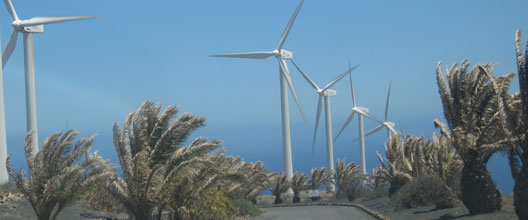
Renewables could satisfy Britain’s electricity needs by 2050, says Loughborough expert
Britain could generate all its electricity from renewable sources by 2050 if politicians grasp the nettle, according to a Loughborough University expert on wind energy.
Simon Watson, Professor of Wind Energy, says it is possible for wind, solar and water power to take over from nuclear, coal and gas within 36 years.
“There is no reason at all why we can’t be generating 100 per cent of our electricity needs from renewables by 2050,” said Professor Watson.
“But it’s down to political will and the social acceptability of it. Also, the fossil fuel lobby is very strong.
“Thirty six years is not a long time to complete the changeover, but think back to where we were in 1990 and how much renewable generation we had then.
“There was some small scale hydro, and renewables were at about two per cent of all electricity generated. Now it’s 15 per cent and it’s accelerating.”
Professor Watson was speaking ahead of his Inaugural Lecture* at the university on Wednesday, October 8 when he will look at some of the main challenges facing wind energy.
Wind power is at the forefront of the drive towards renewable energy at a time when there is increasing demand for carbon-free energy generation to combat climate change caused by CO2 emissions.
Worldwide, there was 320 Gigawatts of wind generating capacity at the end of 2013. This would produce enough electrical energy to power all the households in the EU.
Wind power currently provides about eight of the 15 per cent of our electricity generated by renewables, which also includes solar, biomass and hydro. The rest comes from gas (25-30 per cent), coal (35-40 per cent) and nuclear (15-20 per cent) depending on the relative price of fuel.
But Professor Watson says that figure could easily be more than doubled.
“It’s clear that we need a portfolio that is increasingly lower in carbon content, which means using renewables,” said Professor Watson, who heads up the Wind and Water Power Research Team in CREST (Centre for Renewable Energy Systems Technology), which is part of the School of Electronic, Electrical and Systems Engineering.
“No one power source will meet our requirements. That’s why we need a balanced portfolio.
“Wind power is one of the most mature of the renewable technologies and I see it as being an important part of the portfolio.
“We are a windy country so potentially wind could provide 20 per cent of our electricity within 20 years.”
Critics point to the cost of wind energy, but Professor Watson says on-shore wind farms are cost-efficient and off-shore farms will be once the technology has been developed fully to cope with the hostile marine environment.
“In 20 years’ time they will be as cost-efficient as conventional generators,” he said.
Professor Watson was keen to explode some of the myths and correct the misinformation surrounding wind power. For example:
1. We would need as much back-up capacity as a turbine produces in case it’s not windy. False.
“There are turbines all over the country and the wind does not stop blowing everywhere at the same time. In addition, all generators suffer outages, but we don’t have dedicated back-up for every power station.”
2. Turbines need more energy to manufacture them than they produce. False
“A large wind farm has an energy pay-back time of three to six months, smaller ones slightly longer.”
3. Turbines scare horses. False.
“No evidence”.
4. They are noisy.
“Not if you live more than half a mile away and the siting is done properly. More research, however, is needed on the rhythmic noise made by the blades.”
5. They kill birds and bats.
“The number of birds killed is miniscule compared to the number killed by cars. Good planning means turbines are not built where bats fly.”
6. They never seem to be working.
“If some are not working when others are this may be because it’s not windy enough in that area as the wind can vary substantially over short distances, or they are under repair which happens rarely. Their availability, however, is good - 97 per cent for onshore, nearly 90 per cent offshore.”
7. They are unsightly
“Conventional power stations are not exactly picturesque! I think we need to take more responsibility for our power. Someone in the south west for example might complain about wind farms but are happy to take power from power stations situated further north.”
*Reap the Wild Wind, Inaugural Lecture by Professor Simon Watson on Wednesday October 8 in the lecture theatre T.003, Wolfson Building.